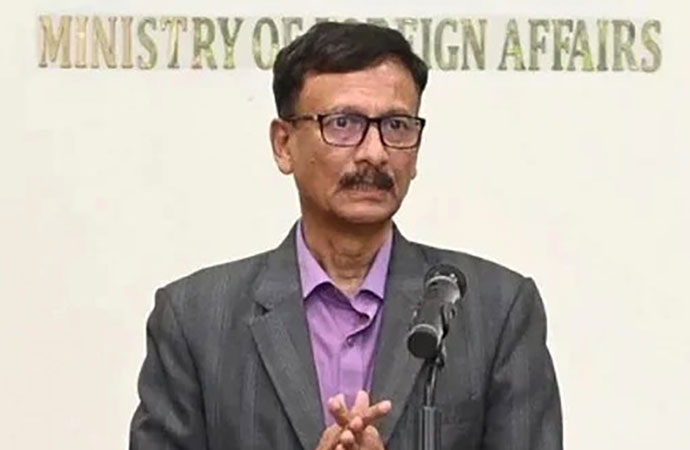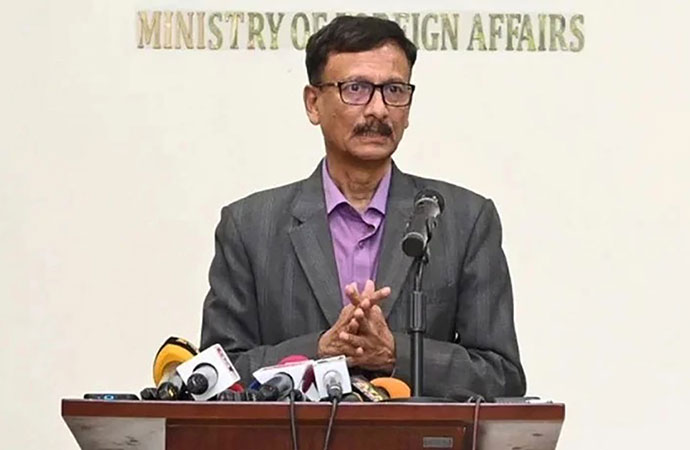Reportage

Flood water flowing over an embankment and entering Gurmar Haor in Tahirpur upazila of Sunamgan. Photo: Collected
Upstream water running down hills following torrential rain in Meghalaya and Cherrapunji of India triggered a second phase of flash floods to hit Sunamganj on Sunday, overflowing the extended Gurmar Haor in Tahirpur upazila.
The flooding has risked some 2,000 hectares of crops that are close to maturing for harvest. Farmers have been considering bringing forward their harvest since the first phase of flash floods.
Khasrul Alam, a farmer from Golabari village, said from Saturday night water level in the haor increased and broke the old permanent dams at the edges.
"If the water continues to enter croplands throughout the day, crops will get damaged. If the water pressure declines in the meantime our crops will be saved," he added.
Following the instruction from the administration, farmers in the haor region were seen rushing to cut half ripened crops as Matian Haor, Shonir Haor, Mohalia Haor, Somsar Haor again faced the risk of being flooded.
In the last 24 hours, 13 mm rainfall was recorded in Sunamganj as upstream mountain flooding continued to raise water level in rivers and haors in the region.
According to the Water Development Board (WDB), at 12pm on Sunday water level in the Surma River was recorded at 5.87 cm, having risen 80 cm in the last 24 hours. Meanwhile, the water level in Jadukata River increased 71 cm and in the Patlai River by 43 cm.
On March 30, Sunamganj haor region was hit by the first phase of flash floods which inundated at least 5,000 hectares of land causing Tk 100 crores worth of losses to farmers.
Karuna Sindhu Chowdhury, Chairman of Tahirpur upazila parishad, said they had been struggling to save crops of Gurmar Haor for the last 15 days.
"With the assistance of farmers, local leaders, and WDB officers, a risky dam in the Bagmara area was reformed but the second phase of the flood has already overflowed the high edges of the haor. Usually we don't need dams in these areas. Already locals are working to resist the water from entering," he said.
Mujibur Rahman, a farmer from Joypur village said, "We are guarding the dams every night along with the administrative staff."
Rayhn Kabir, Tahirpur Upazila Nirbahi Officer (UNO) said, "The dams are not broken but damaged and are not in a very good condition as water pressure keeps increasing. The dams in the Tanguar haor area are at most risk as any of them can collapse at any moment."
Iqbal Al Azad, Jamalganj UP Chairman said,"We have instructed farmers to harvest 80% ripe crops to reduce their losses along with protecting the dams."
"Rainfall is likely to decline both upstream and downstream from Sunday", said Md Jahangir Hossain, Sunamganj Deputy Commissioner quoting the Met Office.
"The dams made of earth have weakened after handling water pressure for the last 15 days. But if we can hold on for a day or two more by working on the damages the danger will have passed as upstream rains are the main reason for flooding here," he added.
According to the district Agricultural Extension Office, this year Boro paddy has been cultivated on 222,805 hectares of land in Sunamganj aiming at a production of 14 lakh metric tonnes.
So far, harvesting has been completed on just 30,530 hectares of land - around 14 percent of the area cultivated.
According to WDB, 536 -km crop protection dams in 12 upazilas were to be established and reformed at 12 upazilas in Sunamganj, under 727 projects spending Tk 122 crore.

























Leave a Comment
Recent Posts
Remembering Kalidas Karmakar ( ...
The art world remembers Kalidas Karmakar, a visionary whose creativity ...
An Evening with Shishir Bhatta ...
Cosmos Art Echo, the artist talk initiative of Gallery Cosmos and Cosm ...
Myanmar denies genocide, calls Rohingya crackdown co ..
Yes, of course
Earth’s average temperature last year hovered among ..
Bangladesh and Singapore: A Tale of Two Nations